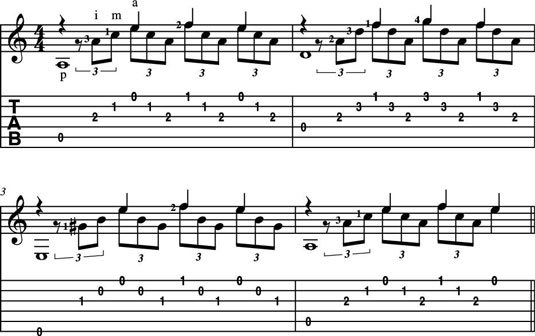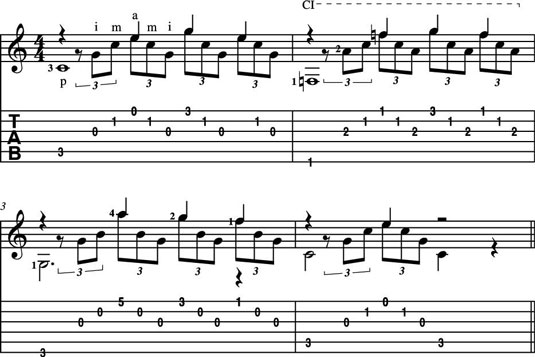Melodies in the bass are a bit easier to combine with arpeggios on the guitar than are melodies in the treble. However, arpeggio pieces with melodies in the treble are actually more common than those with melodies in the bass, and here you look at the technique you use to play such pieces.
Playing arpeggios with the melody in the treble rather than the bass can be a bit trickier for a few reasons, as the following list explains:
Question of fingering: Technically, any given melody note can be taken with any available finger — i, m, or a — and it’s often up to you to decide which to use. (See nearby sidebar for a refresher on the p-i-m-a system.)
Use of the ring finger: Because the i and m fingers usually play accompaniment notes on the inner strings, the a finger takes many melody notes. The problem is that the melody notes must be emphasized, but the ring finger is the weakest.
Question of right-hand technique: You have more than one way to bring out a treble melody from an arpeggio, and it’s up to you to decide which technique to use.
Use of rest strokes: Whereas you play arpeggios with a melody in the bass with free strokes only, you generally combine rest strokes and free strokes when you play arpeggios with a melody in the treble.
Complexity of notation: Standard music notation for arpeggio pieces with a melody in the treble often requires the indication of three separate parts, or voices — one each for the melody, the accompaniment (usually filler notes on the inner strings), and the bass. Normally, stem directions tell you which notes belong to which part (for example, notes with stems up are melody and notes with stems down are bass).
Depending on the musical context (or sometimes simply on the amount of available space), the accompaniment notes may be stemmed either down (sometimes making them hard to distinguish from bass notes) or up (sometimes making them hard to distinguish from melody notes).
Sometimes, at the whim of a composer or arranger, the melody and accompaniment notes are combined into a single voice (as a continuous flow of upstemmed eighth notes, for example), and it’s up to you, using your ear, to discover the real melody.
Although the aforementioned potential complications may cause you concern, remember that most arpeggiated pieces — even those with the melody in the treble — aren’t difficult to play. That’s because, as stated, in such pieces, the left hand generally holds down a chord, and the melody notes themselves are often contained within that chord.
To bring out the melody in the treble, you have to make it either louder than, or different in tone from, the other notes. You can do this simply by
Making the melody notes sound stronger than the others by playing them with rest strokes (and the accompaniment notes with free strokes). You can also try the techniques in the following bullets, but this technique — the use of rest strokes for melody notes — is generally used by classical guitarists, and it’s the one you should strive to perfect.
Striking the melody notes harder than the others (as you do when you bring out a bass melody with the thumb).
Making the melody notes brighter-sounding than the others by using more nail when you strike them (that is, if you play with a combination of flesh and nail, use more nail than flesh on the melody notes, and more flesh than nail on the accompaniment notes).
Playing a treble melody within arpeggios
Here is an exercise that allows you to combine a treble melody with a series of arpeggios. Note that you play the melody in quarter notes (indicated by upward quarter-note stems), that the bass notes are whole notes (and thus must ring throughout each measure), and that the accompaniment notes are eighth-note triplets, which, though they’re written as short notes, should also ring out.
Practice this using rest strokes on all the melody notes. Start out playing slowly (but evenly), then gradually increase your speed. Follow the left-hand fingerings to ensure that you can hold down each chord with your left hand for as long as possible. If necessary, listen to Track 107 to hear how the piece works rhythmically and how the separate voices interact.

Practicing making a treble melody stand out
This example comes from a study by late 19th-century Spanish guitar virtuoso Francisco Tárrega. It employs a consistent right-hand pattern throughout: p-i-m, a-m-i, a-m-i, a-m-i. Play all the melody notes as rest strokes with the ring finger.
Note that the bass notes sustain throughout each arpeggio, but in measure 3, fingering requirements force you to stop the bass from ringing one beat early (as the finger that plays the bass note, the first finger, is suddenly needed on the 1st string to play the last melody note of the measure).


